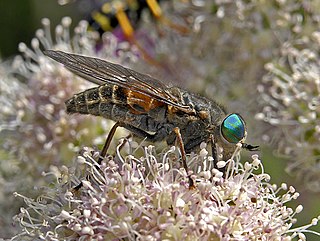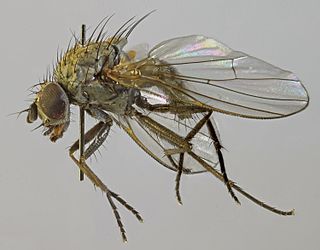
Johan Wilhelm Zetterstedt was a Swedish naturalist who worked mainly on Diptera and Hymenoptera.

Rhagionidae or snipe flies are a small family of flies. They get their name from the similarity of their often prominent proboscis that looks like the beak of a snipe.

Ptiolina is a genus of snipe flies of the family Rhagionidae,. Examples are found in Northwest Europe, where it prefers woodlands areas. and North America

Blepharomyia is a genus of tachinid flies in the family Tachinidae.

Blepharomyia piliceps is a species of fly in the family Tachinidae.

Hybomitra montana, the slender-horned horsefly, is a species of horse flies in the family Tabanidae.

Xylota tarda is a Palearctic species of hoverfly.

Azelia cilipes is a species of fly in the family Muscidae. It is found in the Palearctic.

Chrysopilus laetus is a Palearctic species of snipe fly in the family Rhagionidae.
Rocetelion is a genus of flies belonging to the family Keroplatidae.

Nephrocerus is a genus of flies belonging to the family Pipunculidae.
Brachyopa vittata is a European species of hoverfly.
Ortalischema is a genus of flies in the family Sepsidae.
Nephrocerus flavicornis is a species of fly in the family Pipunculidae.
Cephalops vittipes is a species of fly in the family Pipunculidae.
Eudorylas fuscipes is a species of fly in the family Pipunculidae.
Eudorylas unicolor is a species of fly in the family Pipunculidae.
Dorylomorpha albitarsis is a species of fly in the family Pipunculidae.
Hybomitra auripila is a Palearctic species of horse fly in the family Tabanidae.

Spaniinae is a worldwide subfamily of predatory snipe flies.










